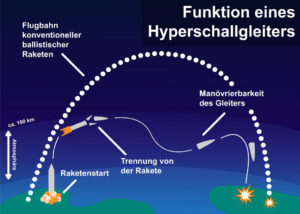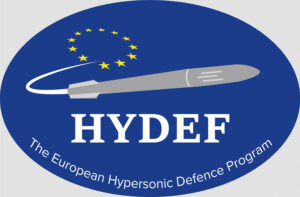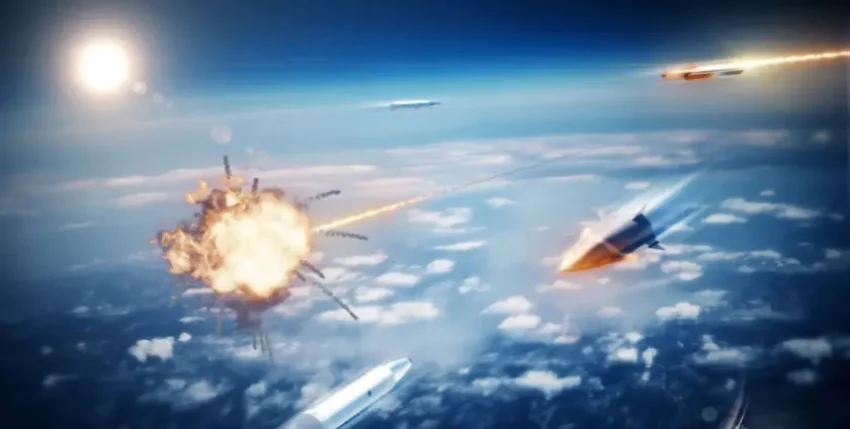Other nations already have Hypersonic missiles. Now there are They are also in the specifications of the future German air defence units.
Hypersonic missiles have come to the attention of air defenders at the latest since the deployment of the "Kinshal" cruise missile by Russia in the Ukraine war. They are among the most advanced and threatening military technologies. Hypersonic missiles challenge all existing missile defence shields with new flight profiles and attack patterns. Existing defence systems need to be significantly enhanced. In the following, the current status of such missiles is analysed and The necessary measures for further development are discussed.
What are hypersonic missiles?
Hypersonic missiles travel through space at speeds of over Mach 5 (approx. 6,200 km/h). Austrian engineer Eugen Sänger was already researching the technology for such a fast suborbital stratospheric gliding missile in the 1930s. National and international research was never completely discontinued, and in 2004 a hypersonic test firing took place at the Wehrtechnische Dienststelle 91 (WTD 91) in Meppen.
There are two main types of hypersonic missiles: hypersonic glide vehicles (HGVs) and hypersonic cruise missiles (HCMs). Thanks to their enormous speed and high manoeuvrability, they are capable of penetrating conventional defence systems.
Hypersonic glide missiles are launched from ballistic missiles to the edge of the atmosphere at high altitudes, where they follow an undulating trajectory or "glide" towards their target at very high speeds (Mach 10-15) at altitudes between 30 and 60 kilometres. In contrast to ballistic missiles, their ability to manoeuvre during gliding flight makes it difficult to predict their trajectory and intercept them.
Hypersonic cruise missiles use ramjet engines, which give them continuous thrust and high speeds. In contrast to HGVs, HCMs fly at lower altitudes of between 20 and 30 kilometres. Their high speed (Mach 5 - 10) makes them detectable primarily by infrared sensors due to the dynamic pressure temperature. The challenge is to "marry" this type of sensor technology with an effector.
Hypersonic weapons in the arsenals

Manoeuvrability, graphic: German Institute for Defence and Strategic Studies
China and the USA already have hypersonic weapons in their arsenals, and many other countries are developing this technology. In Russia, the HGV Avangard was presented by Russian President Vladimir Putin in March 2018 along with five other "miracle weapons", which he described as "technical breakthroughs and guarantors of Russia's security for several decades to come". In Russia's view, they are intended to secure the country's second-strike capability and maintain the nuclear balance, which Russia sees as threatened since the USA withdrew from the Anti-Ballistic Missile Treaty and by the global expansion of US missile defence systems. These US missile defence systems are to be literally outmanoeuvred by the new technology. At the beginning of 2024, 10 Avangard gliders were reportedly already operational.
Currently no defence options
The speed and manoeuvrability of hypersonic missiles pose a considerable threat in themselves. Extremely short warning times and the weapons' ability to fly complex trajectories make them even more dangerous than other missiles. The conventional air defence systems currently available, which are based on the detection and defence of subsonic and supersonic threats, are hardly capable of detecting and combating genuine hypersonic missiles. However, flight in the hypersonic range generates extreme frictional heat, which can be detected at an early stage by heat-sensitive sensors. They could therefore actually be detected.
 According to Russian information, the Kinschal cruise missiles, which have already been used several times in the Ukraine war, are said to be Mach 10 fast. Ukrainian observations and the fact that such a cruise missile could be shot down by a Patriot air defence system suggest that a speed of only Mach 3.5 prevailed due to the low altitude and the associated high air resistance.
According to Russian information, the Kinschal cruise missiles, which have already been used several times in the Ukraine war, are said to be Mach 10 fast. Ukrainian observations and the fact that such a cruise missile could be shot down by a Patriot air defence system suggest that a speed of only Mach 3.5 prevailed due to the low altitude and the associated high air resistance.
Nevertheless, reliable interception remains unlikely at present. The vast majority of existing air defence systems were developed at a time when hypersonic was not yet an issue. The defence missiles currently available in the inventory of most NATO navies are not suitable for intercepting hypersonic missiles. New technologies and tactics are needed to establish a defence capability.
What to do ?
In view of the growing threat posed by hypersonic weapons, engineers and military forces around the world are working on the development of new defence systems and strategies. These include modern sensor systems that are capable of recognising hypersonic missiles at an early stage and precisely tracking their trajectories. Phased array technologies are currently being combined with artificial intelligence in such systems in the West. China is relying on a different technology, microwave photonics radar. The innovation in this new radar system lies in the combination of lasers with three different microwave bands. The use of multi-band microwave signals and a specially developed algorithm is intended to increase the accuracy and speed of the system in line with the threat.
Another important factor is new interceptor missiles, which must be fast, agile and high-altitude capable enough to combat hypersonic missiles. Laser weapons that can destroy hypersonic targets precisely and at the required speed would be faster and probably cheaper to equip. The high structural load of hypersonic flight facilitates destruction. In any case, laser weapons can be an effective addition to existing defence systems. And because hard kill always includes soft kill, electronic warfare systems that disrupt the communication and control systems of missiles can help to optimise defence. The use of jammers and cyber measures could significantly reduce the threat.
Last but not least, the complex processes "to the left of the firing button" of the air defence systems must be significantly accelerated. This refers to situation picture generation, correlation and exchange, processes that need to be further automated in line with the threat. In many cases, today's defence systems are already overwhelmed at high supersonic speeds.
Hypersonic technologies also relevant for the German Navy
The US Navy assumes that its aircraft carriers and amphibious landing ships are under threat from HGVs and HCMs. In this respect, the statements in this article are also increasingly relevant for naval forces. Strictly speaking, anti-ship ballistic missiles are not hypersonic missiles in the sense of the above definition, but nevertheless reach hypersonic speeds on their ballistic trajectory. Therefore, many of the statements made here also apply to anti-ship ballistic missiles.

In the German Navy, hypersonic technologies and their threat were already being discussed in 2016 in parallel with the developments in Russia. At that time, the planning department of the naval command initiated initial studies on defence against hypersonic missiles. The studies triggered the current projects on hypersonic technologies in the Bundeswehr. In this context, the requirement for the future F127 air defence ships to be equipped with a corresponding hypersonic interceptor also arose in 2019.
EU projects HYDEF, HYDIS and TWISTER to close capability gap
In the meantime, the initial national studies have been merged into the multinational Hypersonic Defence (HYDEF) programme under the leadership of the European Armaments Management Organisation OCCAR[i]. The aim of the programme is to develop an overall system to defend against hypersonic threats. This overall system is to include various sensors, some of which are space-based, as well as a hypersonic interceptor. For the
The Spanish company SMS was selected as the project manager for the HYDEF project. The German company Diehl Defence is responsible for the technical implementation, from the development of the overall system to the interceptor missile itself. This interceptor could be a further development of the well-known IRIS-T missile. In future, HYDEF should be able to detect and intercept both HCMs and HGVs.
In addition to HYDEF, the European Commission is also funding the HYDIS² (HYpersonic Defence Interceptor Study) study by MDDA. HYDIS² was already selected for funding in July 2023. Germany, France, Italy and the Netherlands have opted for co-financing. According to MBDA, HYDIS² stands for the concept architecture and technology maturity study of an endo-atmospheric interception system against new high-end threats. The study was proposed by the HYDIS² consortium, led by MBDA, to develop a new interception system against hypersonic and ballistic threats for the needs of European nations. - In 2028, the EU will then compare the two systems and choose one of them for realisation.
The command and control system is based on the existing NATO BMD[ii] command and control systems. HYDEF is closely linked to the "Timely Warning and Interception with Space-based Theatre Surveillance" (TWISTER) project, which is also managed by the EU as part of PESCO[iii]. Both projects aim to eliminate the capability gaps of the European NATO states in this area against hypersonic missiles, particularly in the area of ground-based air defence. In parallel to international research in the field of hypersonics, national research is also being driven forward by the Bundeswehr's Hypersonic Competence Centre, which is based at WTD 91. Naturally, sea-based air defence can also participate in this development.
Conclusion
Hypersonic missiles place high demands on air defence. Their high speed and great manoeuvrability make them difficult to detect and intercept. Germany is working with its European partners on solutions for weapons, sensors and guidance systems. In fact, European scientists and engineers in the field of hypersonic technology have gone from a study to the first successfully flying demonstrators in just a few years.
Naval forces can benefit from the development of the above-mentioned hypersonic systems, as such systems also enable defence against anti-ship ballistic missiles. For the German Navy, HYDEF/HYDIS and the influx of air defence ships, which are still in the design phase, appear to offer a certain temporal parallelism with the opportunity to close a capability gap here. Should the situation prove to be virulent before then, a laser on board a frigate 124 - integrated into a corresponding sensor network - would be an option.
Andreas Uhl










